Test – XFX R9 Nano: Review |Specs | CPU | Hashrate |Pros & Cons |Config | Set-up . Despite the latest generation cards AMD has not really been on the rise lately, between the successive renaming and the fairly high consumption of the cards it was necessary to put a good kick in all this by releasing a model that stands out from the crowd, which earned us a test today!
The R9 Nano is a card that wants to be mainly designed to be installed in a mini ITX box, hence its length of 15 cm, which will allow it to be installed in all boxes on the market (without those that do not have extension squares of a “normal” height). Where AMD wants to strike a blow is the performance / size ratio, in fact the little beast has the same architecture as the ultra high-end cards of the brand, the Fury, therefore equipped with HBM memory (soldered directly next to the GPU, therefore a significant space saving) and a Fiji GPU, enough to have excellent performance.The R9 Nano was available at launch at a recommended price of € 690 but AMD decided to revise this down recently, it is now possible to find the beast at 549.90 €, a much more interesting performance / price ratio? This is what we will see!
Characteristics – XFX R9 Nano
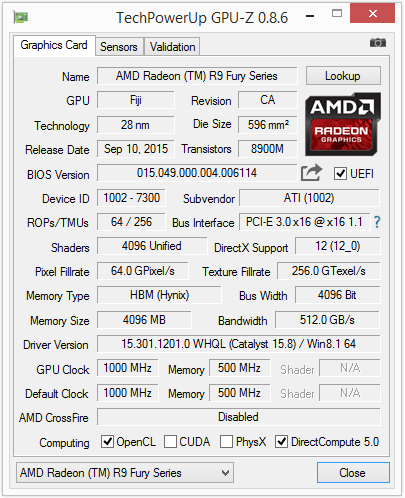
Specification: Hashrate – XFX R9 Nano
| AMD R9 Fury X | AMD R9 Fury | XFX R9 Nano | |
|---|---|---|---|
| GPU | Fiji | Fiji | Fiji |
| Engraving fineness | 28 nm | 28 nm | 28 nm |
| Calculation units | 4096 | 3584 | 4096 |
| Texture units | 256 | 224 | 256 |
| GPU frequency with boost | 1050 MHz | 1000 MHz | 1000 Mhz |
| Memory Frequency | 500 MHz | 500 MHz | 500 MHz |
| Memory | 4 Go de HBM | 4 Go de HBM | 4 Go de HBM |
| Memory bandwidth | 512 Go/s | 512 Go/s | 512 Go/s |
| Connectivity | 1 x HDMI 1.4a 3 x mini Display Port | 1 x HDMI 1.4a 3 x mini Display Port | 1 x HDMI 1.4a 3 x mini Display Port |
| Dimensions | 19.4 x 10.2 x 4.2 cm | – | 15.2 x 10.2 x 4.2 cm |
| Food | 2 x 8-pin | 2 x 8-pin | 1 x 8-pin |
| TDP Maximum | 385 Watts | 385 Watts | 185 Watts |
| Guarantee | 2 years | 2 years | 2 years |
| Suggested price | 710€ TTC | 590€ TTC | 549.90€ TTC |
As we can see the XFX R9 Nano on paper is pretty much an R9 Fury X, same “Fiji” GPU, same number of compute units and both have 4 GB of HBM clocked at 500 MHz, the only little thing that sets them apart on paper is the GPU frequency which is 1050 MHz on the Fury X against 1000 MHz on the Nano.
Despite everything AMD to be able to release a card as small as the R9 Nano with its 15.2 cm in length had to make concessions in terms of consumption, indeed when a Fury X can consume up to 385 Watts (maximum value) the Nano for its part is content with 185 Watts, this will greatly limit the holding of the maximum frequency in games, indeed Mr Powertune will be there to calm the ardor of the beast long before his big sister. When a Fury X can hold its maximum frequency in almost all situations the Nano will have a lot more trouble and will be “restricted” (often around 850 MHz, so still a good drop compared to the original 1000 MHz). ), of course without even taking into account the temperature of the GPU which is also taken into account (85 °).
However, AMD clearly does not have the same claims for the Nano as its big Fury X, the latter is designed to be installed in a “classic” configuration while the Nano in a very small mini-ITX box, the 2 will therefore clearly not shade.
Offered at a revised price of € 549.90 including tax, the R9 Nano is now priced at a GTX 980, the latter having no equivalent in terms of dimensions, the closest card being a GTX 970 (the Gigabyte GTX N970IX and Asus GTX970), which are cheaper but certainly less efficient as well.
Box and bundle
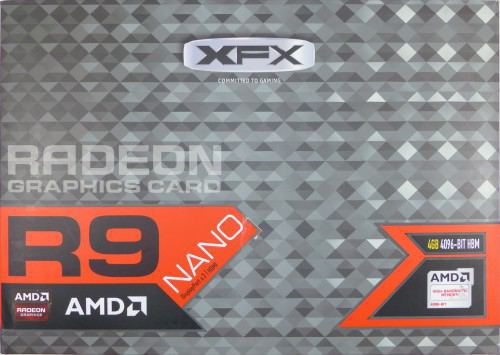
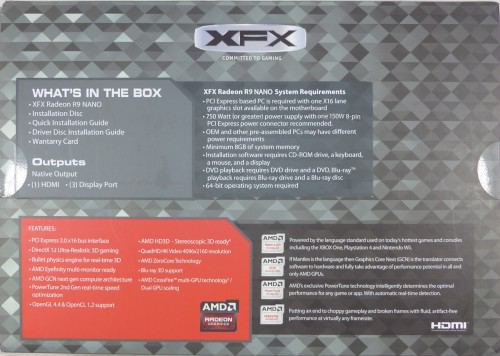
One thing is certain at XFX, once the design of the box is found it is declined for years on all cards! Not that it changes anything anyway, the whole is sober. At the front we find the model, the amount of memory, the available connections etc. At the rear a listing of the contents of the box, the main features and the minimum configuration (we can also see that XFX requires a power supply minimum 750 Watts… again very very largely oversized).
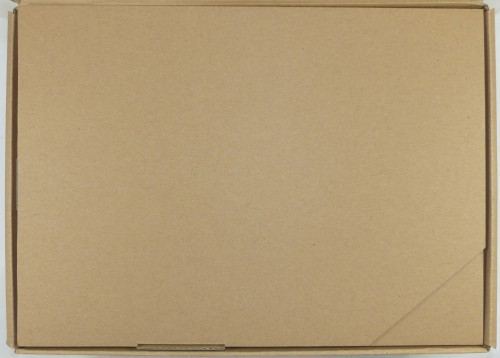
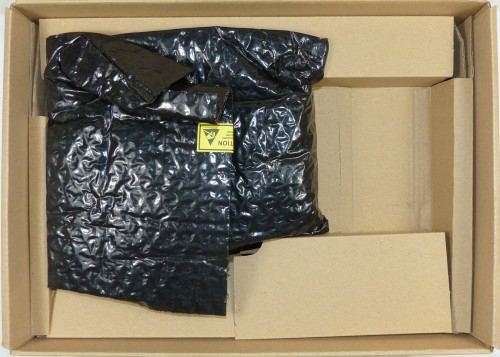
Inside the box we fall on the cardboard containing the bundle, below the latter the beast well wrapped in bubble plastic, as I said above the cardboard of the other card models is clearly reused, the mold being much larger than the Nano itself 😉 (As we can see on the brand’s R9 390X for example here).
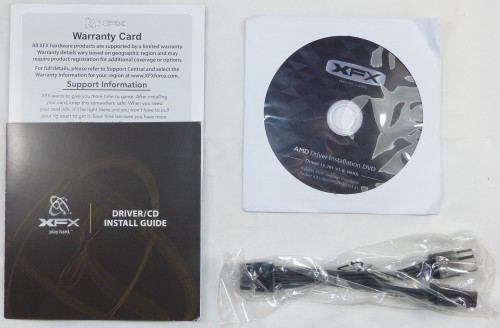
The bundle consists of:
- 1 DVD de drivers
- 1 warranty card
- 1 guide d’installation
- 1 adapter 2 x 6-pin -> 1 x 8-pin
We are in the presence of a very classic bundle in terms of graphics cards, in addition to the eternal DVD of drivers and the quick installation guide the adapter could prove useful if ever we run out of connectors (this which is not really a good sign though).
The map
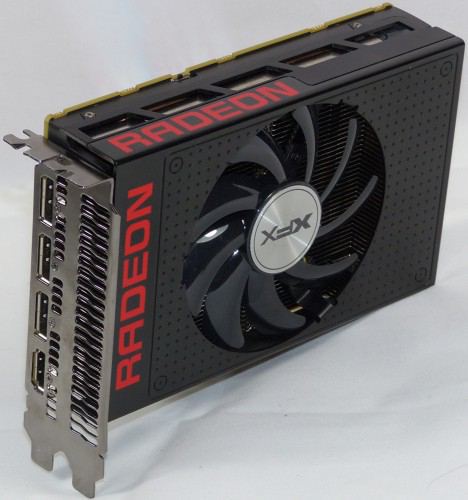
Here is the beast! The first thing that strikes you is its small size, indeed with 15.2 cm in length it changes monsters of more than 30 cm that there are more and more 😉 Despite its small size the card is very solid thanks to its fairing in metal, plastic has no place here! XFX has not touched the reference design and offers a completely identical card to the reference one, except that the logo on the fan changes.
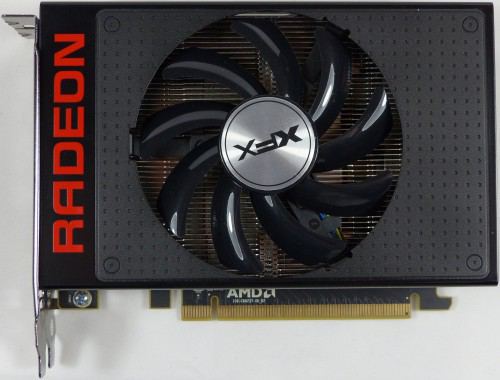
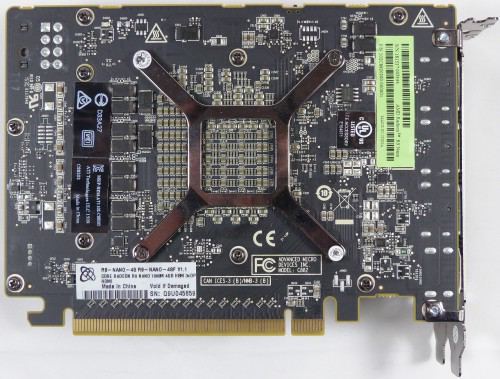
A good brick, if I had to qualify the R9 Nano, a fan only in the center of a black rectangle, the only thing that disturbs the sobriety of the whole is the “RADEON” on the side, you never know you have to how well it shows! Note that the card hardly exceeds the length of the PCIe slot, a joy for those who are sorely lacking in space.


As I said metal fairing, a big “RADEON” on the top to be sure that you can see the mark well, you have to show the beast a little 😉 You can also see the aluminum fins of the cooler.

At the rear we can see the aluminum fins much better, the air will be expelled not only outside the case but also inside. Contained consumption also goes with a single 8-pin power connector, at least we will stay in the nails and there will be no need for a power supply with 2 PCIe connectors.
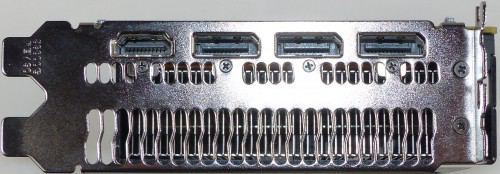
Connectivity level AMD has said stop to DVI, it is here a question of 3 Display Port connectors and 1 HDMI 1.4 connector. You can also see the vents that will allow the expulsion of part of the hot air outside the case.
We undress the map

With the cooler removed we realize even better the small size of the R9 Nano, indeed there is not much here the GPU + memory block and the VRMS (to summarize quickly). Indeed, thanks to the HBM memory directly integrated into the packaging of the GPU (the 4 small rectangles glued to the GPU) the need for space is much reduced, hence the drastic reduction of the PCB.
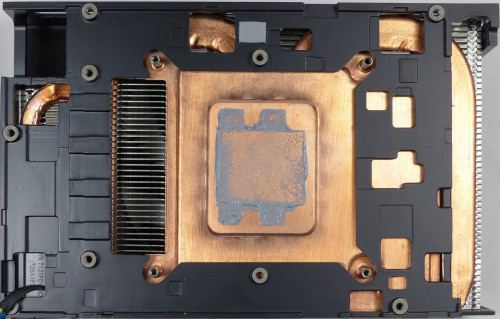
The cooler consists of a large copper plate directly in contact with the GPU and the memory, all cooled by 2 large heat pipes in contact with the aluminum fins. Another heat pipe (on the left in the photo) is there to cool the VRMs on the card. The metal plate also acts as a cooling unit, in contact with the various components of the card.
The test platform
The configuration used during the tests is as follows:
- Processeur: Intel Core i5 4670K @ 4 Ghz
- Motherboard : Gigabyte Z87-UD5H TH
- Mémoire: Kingston HyperX 4 x 2 Go 1600Mhz
- Disque dur: WD Raptor 150 Go
- Power supply : Seasonic X650
- Drivers: Catalyst 16.1
- Operating system : Windows 8.1 64bits
All games will be tested in 1920 × 1080 detail in full detail (except the TressFX on Tomb Raider), which is the current ‘standard’, the graphics cards used in testing are as follows:
- Asus GTX770 DirectCU OC
- HIS R9 290 iPower IceQ X² OC 4GB (testée ici)
- MSI R9 280X Gaming (tested here)
- MSI R9 290 Gaming OC 4GB (tested here)
- Powercolor R9 280X (tested here)
- Sapphire 7950 Dualx @ 900Mhz
- Sapphire 7970 Ghz Edition
- Sapphire R9 280X VaporX Tri-X (tested here)
- XFX R9 280 Double Dissipation (tested here)
- XFX R9 285 Black Edition (tested here)
- XFX R9 380 Double Dissipation (tested here)
- XFX R9 290 Double Dissipation (tested here)
- XFX R9 390 Double Dissipation Core edition (tested here)
Consumption / Temperature
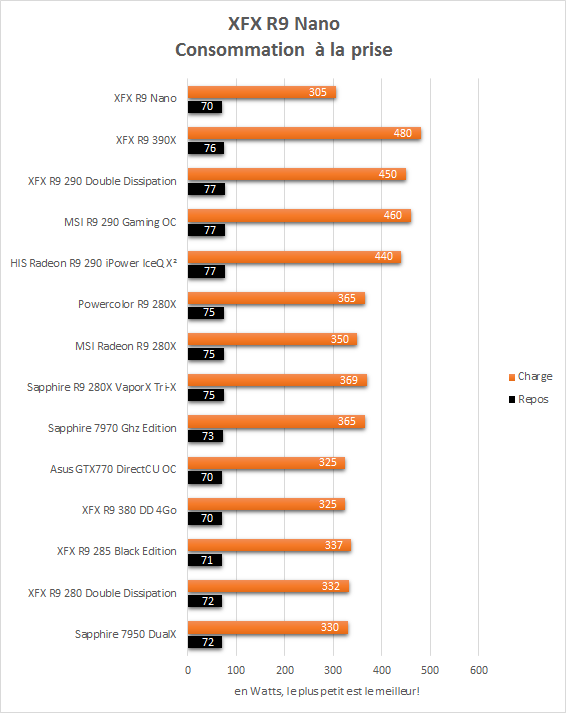
The consumption test was carried out under OCCT Power Supply which makes it possible to push the consumption of the components to the maximum, note that this value reflects the total consumption at the outlet of the machine and not the graphics card itself!
As we can see the consumption of the configuration equipped with the XFX R9 Nano is really very contained, in fact it is more contained than with all the other cards in the comparison! With 305 Watts in load the configuration turns out to be really very energy efficient, a godsend for those who want to have a muscular configuration in a small box, because yes it is much more recommended to have a configuration that consumes “little” in a mini-ITX type case.
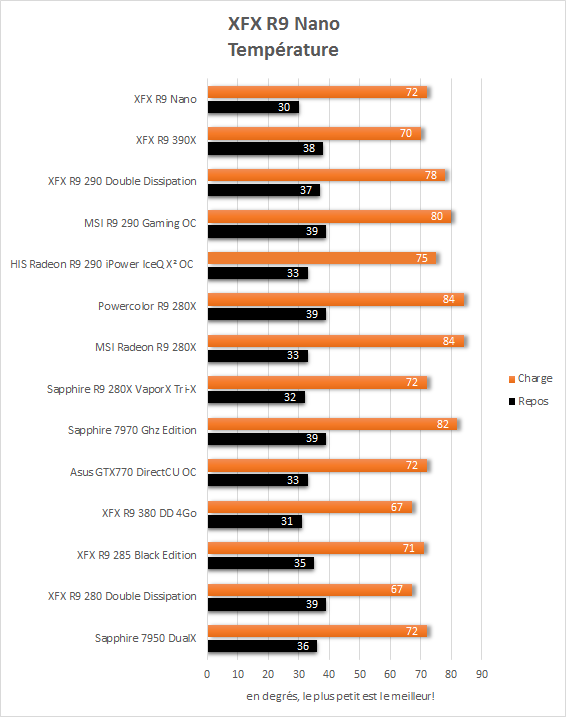
In terms of temperatures and thanks to low consumption, the R9 Nano displays a small 72 °, despite the cooler much smaller than all the other cards in the comparison. With 72 ° we are far enough from the 85 ° that would trigger Mr Powertune, we can say that we worked well at AMD.
Sound level
Warning: Part to be taken with a grain of salt, unfortunately not having access to the appropriate equipment and using an android application to take the readings The measurements below are only indicative! The readings were taken 20cm from the graphics card.
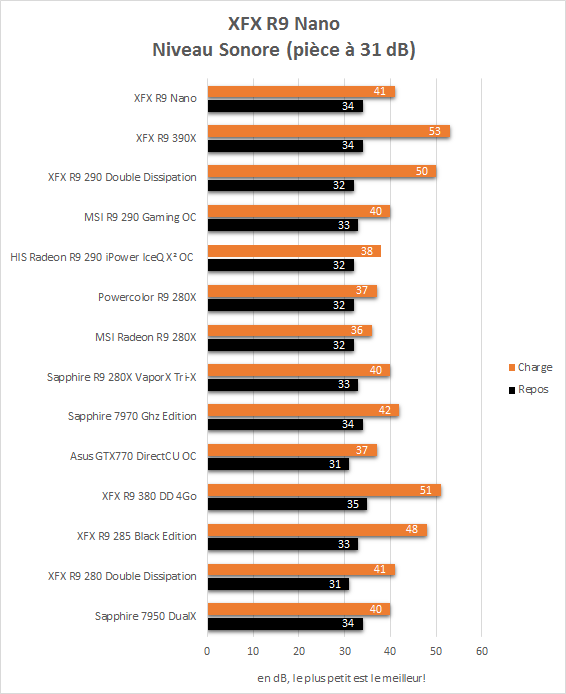
One would have thought seeing the smallness of the card that the noise pollution would have been very high in load, but it is not! At rest the card displays a small 34 dB, which is not entirely silent but should not be heard in a box (the fan runs at 1500 RPM for information). Despite the 41 dB in load, we cannot qualify the R9 Nano as noisy, it is certainly audible but it will not disturb our little ears once in a box, it is also quite honestly quite surprising, thank you for the consumption contained !
Powertune
To start, let’s take a look at the Powertune that powers the XFX R9 Nano 4Go. Powertune is responsible for maintaining the temperature of the processor, the consumption of the card below certain values. During overclocking it is mandatory to be able to modify all the possible settings in order to get the best performance, for Powertune and the R9 Nano series it is possible to increase the consumption limit of the card by 50% (Like the R9 290 / 290X / 390 / 390X).
Let’s see how the GPU reacts when subjected to OCCT:
Factory settings, OCCT :

Here we come head-to-head with Mr Powertune, indeed the basic consumption limit is aggressive and drops the GPU to around 750 MHz during a heavy load. let’s see what it gives under 3D Mark Fire Strike, which represents a bit better a load in a game:
Factory settings, 3DMark Fire Strike :

It’s a little better under 3DMark, in fact we go here to around 850 MHz, it is certainly quite far from the 1000 MHz boost frequency but nothing out of the ordinary, AMD itself gives the R9 Nano for turn around this frequency in games.
On the other hand, and like all AMD cards, it is possible to increase the consumption limit, this will of course lead to higher consumption, as well as of course greater heating and higher noise pollution, but should allow the card to operate at higher frequencies. Let’s see this under OCCT:
Consumption limit + 50%, OCCT :

Indeed once the consumption limit is raised the card is able to maintain a small 910 MHz under OCCT, which is still nicer than the 750 MHz observed above. On the other hand and once again OCCT does not represent practical consumption, the card is pushed to its limits and there will never be the same load in games. Let’s see what this gives in 3DMark:
Consumption limit + 50%, 3DMark Fire Strike :

Under 3DMark the card manages to stabilize at 1000 MHz, which is still more interesting than with the original settings. On the other hand at this stage there the graphics card rises to a temperature of 82 °, the fan makes much more noise and consumption explodes, as we will see later during overclocking.
Games
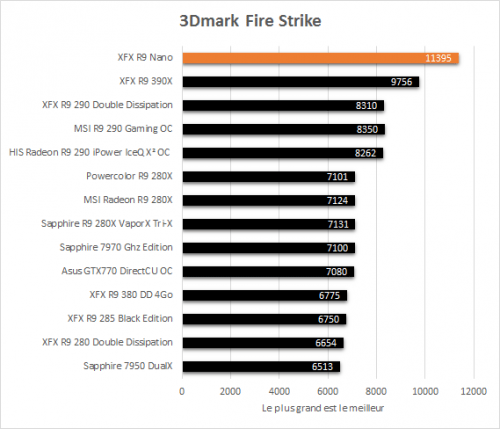
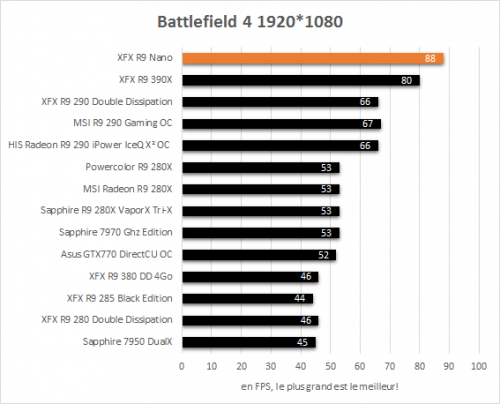
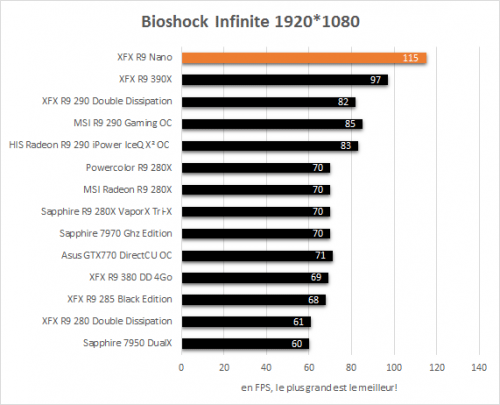

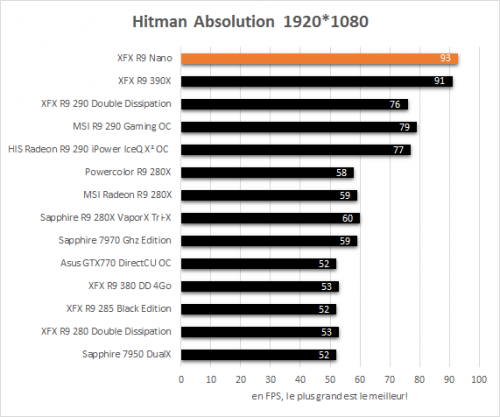
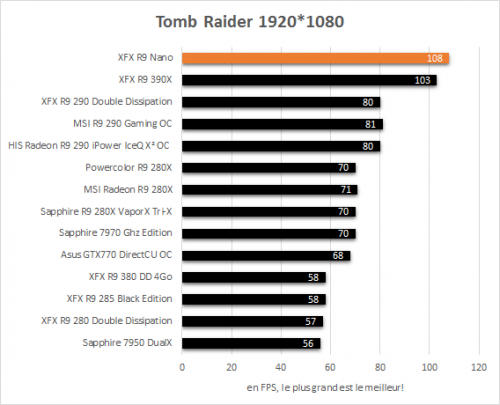
Summary of performance
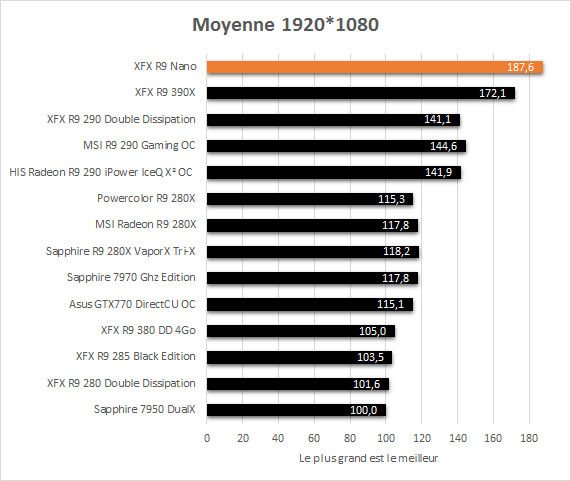
The performance is compared to a Sapphire HD7950 DualX, which has a 100 base :
As we can see the performance of the small R9 Nano is really very good, the R9 390X which was the most powerful graphics card tested at Conseil Config is dropped, the R9 Nano is 9% faster than the latter! Games won’t stand up to it, especially if you’re playing at 1920 x 1080, and have a 144Hz screen (although you’ll have to make some concessions to have such a consistently high FPS rate).
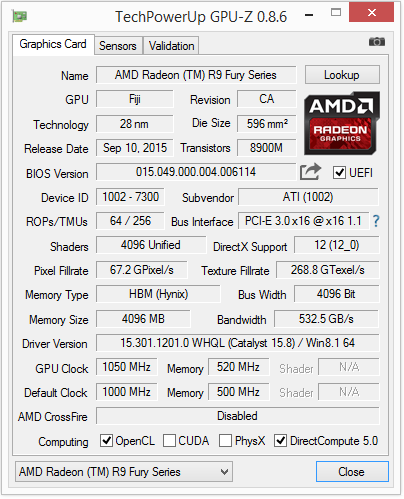
In order to get the best possible idea of the overclocking capabilities of the R9 Nano, and to have as little frequency drop as possible, the fan has been set to 100%. Seeing the size of the card (more precisely the cooler) and the results below the increase in voltage would have been counterproductive for the GPU frequency stability, so the overclocking will only be done at the original voltage:
- GPU: 1050 Mhz (+50 Mhz)
- Memory : 520 Mhz (+ 20 Mhz)
As we can see the XFX R9 Nano is not really made for overclocking, which is nothing surprising. With 50 MHz more on the GPU and 20 MHz more on the memory the gains should not be really huge compared to what we originally. However, the thing that should largely impact the results is the increase of the consumption limit by 50%, indeed as we could see it above the card holds a much higher frequency with this increased limit (approximately 850 MHz against 1000 MHz).
Consumption
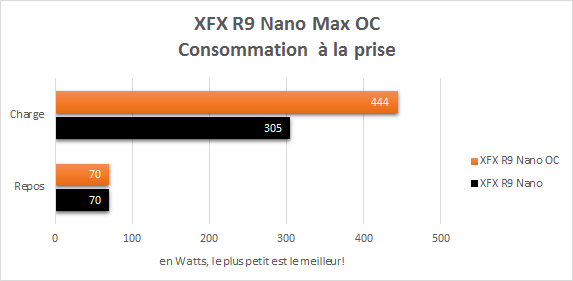
It is clear that the option that limits consumption is not there for nothing! Indeed we go from a very reasonable 305 Watts to 444 Watts! An increase that is not trivial and will logically not be suitable for a mini ITX box, even if 444 Watts is not huge for a gamer configuration. Once again the readings were taken at the outlet, and for the complete configuration !
Temperatures
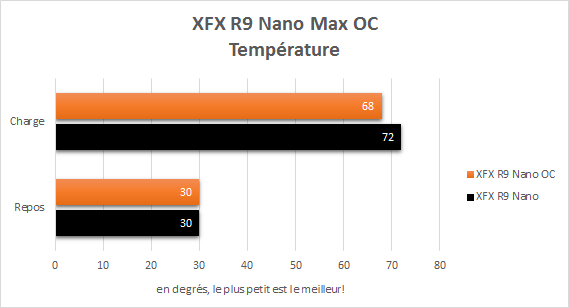
Fan at 100% forces the temperature to drop a little, we go from 72 ° to 68 °, there is not much to see here.
Now that we have seen the consumption and the temperatures, we must see what this gives in terms of noise pollution, the fan is set to 100% in order to keep the temperature and operating frequencies under control, so be careful with your ears.
Sound level
Warning: Part to be taken with a grain of salt, unfortunately not having access to the appropriate equipment and using an android application to take the readings The measurements below are only indicative! The readings were taken 20cm from the graphics card.
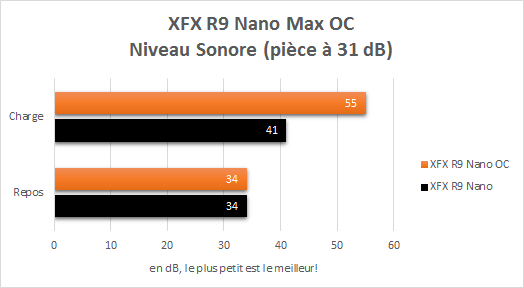
No really need to draw you a picture, at 100% the fan displays a good little 55 dB, and for good reason because it runs at a speed of 3700 RPM. Suffice to say that the card is not at all pleasant to use, unless you have a headset it will break your ears, but this is the price to pay to make the most of the card.
Powertune
OC – Consumption limit + 50%, OCCT :

With the consumption limit increased to the maximum and the small overclock we gain about 10 MHz to go from about 910 MHz to 920 MHz, nothing that could not change much on OCCT.
OC – Consumption limit + 50%, 3DMark :

When we observed a 1000 MHz held with the increase in the consumption limit but without the overclock here we can see that we start at 1050 MHz and drop to around 1000 – 1020 MHz under 3DMark. What can we conclude? Well there is no point in trying to overclock the R9 Nano, it is already difficult to maintain the boost frequency without overclocking, so overclocking will be nonexistent at best.
Results
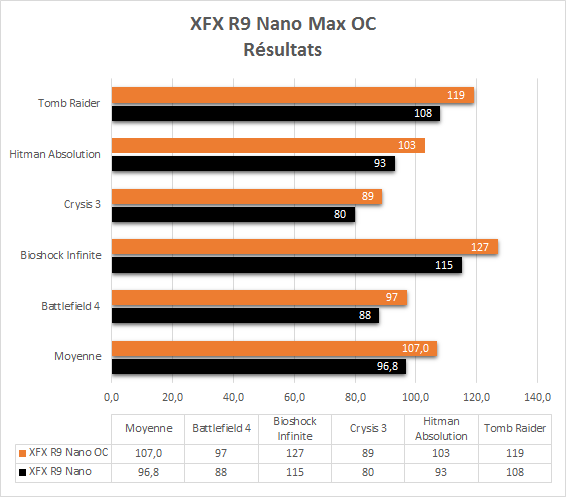
As we can see the results are very satisfactory, we gain about 10.5% by pushing the card to its limits, I do not have a Fury X on hand but the results should really be very close between the 2 cards. Again, the results are not related to the overclocking itself but rather the increase in the power limit, in addition to the fan on full blast and the fuel consumption exploding.
To summarize, it is possible to exploit the full potential of the R9 Nano, but this will come at the cost of high noise pollution and greater consumption, which goes against what these gentlemen from AMD want. for the map.
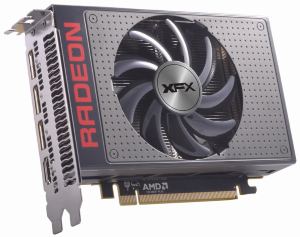
Here we are at the end of this test, what to say about the XFX R9 Nano?
AMD is back on the front of the stage with a card that aims to reach a niche market, indeed the R9 Nano is a card that clearly shows its willingness to settle in a mini-ITX gamer configuration. The consumption of the card is under control, the noise pollution contained, the performance is first-rate and all in a card that does not exceed 15 cm in length!
The R9 Nano is clearly a technology showcase at AMD in terms of performance / size ratio, it is to date the small graphics card that will be installed in all the most powerful boxes on the market.
Offered at a revised price of € 549.90, the XFX R9 Nano will undoubtedly meet the expectations of aspiring gamers to have the most powerful mini-ITX configuration possible.
Advantages
- Performance / size ratio
- Cut
- Contained consumption
- Noise nuisance (in relation to its size)
Disadvantages
- Studied for a niche market
A big thank you to Jérémie and Jean-Manuel from Goldenfish who allowed me to do this test.
















